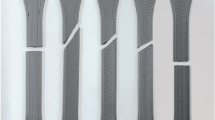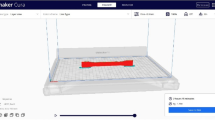Abstract
In contrast to conventional subtractive manufacturing methods which involve removing material to reach the desired shape, additive manufacturing is the technology of making objects directly from a computer-aided design model by adding a layer of material at a time. In this study, a comprehensive effort was undertaken to represent the strength of a 3D printed object as a function of layer thickness by investigating the correlation between the mechanical properties of parts manufactured out of acrylonitrile butadiene styrene (ABS) using fused deposition modeling and layer thickness and orientation. Furthermore, a case study on a typical support frame is done to generalize the findings of the extensive experimental work done on tensile samples. Finally, fractography was performed on tensile samples via a scanning digital microscope to determine the effects of layer thickness on failure modes. Statistical analyses proved that layer thickness and raster orientation have significant effect on the mechanical properties. Tensile test results showed that samples printed with 0.2 mm layer thickness exhibit higher elastic modulus and ultimate strength compared with 0.4 mm layer thickness. These results have direct influence on decision making and future use of 3D printing and functional load bearing parts.
















Similar content being viewed by others
References
ASTM International, Standard Terminology for Additive Manufacturing Technologies (Withdrawn 2015)—ASTM F2792-12a (ASTM International, West Conshohocken, 2012)
T. Letcher, B. Rankouhi and S. Javadpour, Experimental study of mechanical properties of additively manufactured ABS plastic as a function of layer parameters, ASME 2015 Int. Mech. Eng. Cong. and Exp., 2015, p. V02AT02A018-V02AT02A018.
“Wohler’s Report, 3D Printing and Additive Manufacturing State of the Industry, Annual Worldwide Progress Report”, 2014, Wohler’s Associates, 2015, p. 20.
B.M. Tymrak, M. Kreiger, J.M. Pearce, Mechanical properties of components fabricated with open-source 3-D printers under realistic environmental conditions. Mater. Des. 58, 242–246 (2014)
A.R. Torrado, D.A. Roberson, Failure analysis and anisotropy evaluation of 3D-printed tensile test specimens of different geometries and print raster patterns. J Fail. Anal. Preven. 16(1), 154–164 (2016)
D. Croccolo, M. De Agostinis, G. Olmi, Experimental characterization and analytical modelling of the mechanical behaviour of fused deposition processed parts made of ABS-M30. Comp. Mat. Sci. 79, 506–518 (2013)
A. Bellini, S. Güçeri, Mechanical characterization of parts fabricated using fused deposition modeling. Rapid Prototyp. J. 9(4), 252–264 (2003)
S. Ahn, M. Montero, D. Odell, S. Roundy, P.K. Wright, Anisotropic material properties of fused deposition modeling ABS. Rapid Prototyp. J. 8(4), 248–257 (2002)
J.F. Rodríguez, J.P. Thomas, J.E. Renaud, Design of fused-deposition ABS components for stiffness and strength. J. Mech. Des. 125(3), 545–551 (2003)
E. Ulu, E. Korkmaz, K. Yay, O.B. Ozdoganlar, L.B. Kara, Enhancing the structural performance of additively manufactured objects through build orientation optimization. J. Mech. Des. 137(11), 111410-111410-9 (2015)
B.H. Lee, J. Abdullah, Z.A. Khan, Optimization of rapid prototyping parameters for production of flexible ABS object. J. Mater. Process. Technol. 169(1), 54–61 (2005)
A.K. Sood, R.K. Ohdar, S.S. Mahapatra, Parametric appraisal of mechanical property of fused deposition modelling processed parts. Mater. Des. 31(1), 287–295 (2010)
R. Anitha, S. Arunachalam, P. Radhakrishnan, Critical parameters influencing the quality of prototypes in fused deposition modelling. J. of Mater. Process. Technol. 118(1–3), 385–388 (2001)
M. Vaezi, C.K. Chua, Effects of layer thickness and binder saturation level parameters on 3D printing process. Int. J. Adv. Manuf. Technol. 53(1), 275–284 (2011)
R. R. Ma, L. U. Odhner, and A. M. Dollar, A modular, open-source 3d printed underactuated hand, Robot. Auto. (ICRA), IEEE Int. Conf., 2013, p. 2737-2743.
J. Won, K. DeLaurentis, C. Mavroidis, Rapid prototyping of robotic systems. IEEE Int. Conf. Rob. Auto. 4, 3077–3082 (2000)
K. J. De Laurentis, F. F. Kong, and C. Mavroidis, Procedure for rapid fabrication of non-assembly mechanisms with embedded components, ASME Int. Des. Eng. Tech. Conf. Comp. Info. Eng. Conf., 2002, p.1239-1245.
J.T. Belter, A.M. Dollar, Strengthening of 3D printed fused deposition manufactured parts using the fill compositing technique. PLoS ONE 10(4), e0122915 (2015)
Y. Jin, J. Plott, R. Chen, J. Wensman, A. Shih, Additive manufacturing of custom orthoses and prostheses–A review. Procedia CIRP 36, 199–204 (2015)
S. Telfer, J. Pallari, J. Munguia, K. Dalgarno, M. McGeough, J. Woodburn, Embracing additive manufacture: implications for foot and ankle orthosis design. BMC Musc. Dis. 13(1), 1–9 (2012)
“Standard test method for tensile properties of plastics”, ASTM D638-14, ASTM International, West Conshohocken, PA, 2014.
“Standard test method for tensile properties of polymer matrix composite materials”, ASTM D3039/D3039M – 14, ASTM International, West Conshohocken, PA, 2014.
L. Li, Q. Sun, C. Bellehumeur, P. Gu, Composite modeling and analysis for fabrication of FDM prototypes with locally controlled properties. J. Manuf. Proc. 4(2), 129–141 (2002)
A.R. Torrado Perez, D.A. Roberson, and R.B. Wicker, Fracture surface analysis of 3D-printed tensile specimens of novel ABS-based materials, J. Fail. Anal. Preven., 14(3), 2014, p. 343-353.
Acknowledgments
The authors would like to thank Joseph Robertson for his consultation on statistical analyses. The experiments presented in this study were performed in Material Evaluation and Testing Laboratory (METLAB) in the mechanical engineering department at South Dakota State University (SDSU). Financial support for this paper was provided by Advanced Manufacturing Process Technology Transition & Training Center (AMPTEC) under Contract Number 3S6674.
Author information
Authors and Affiliations
Corresponding author
Rights and permissions
About this article
Cite this article
Rankouhi, B., Javadpour, S., Delfanian, F. et al. Failure Analysis and Mechanical Characterization of 3D Printed ABS With Respect to Layer Thickness and Orientation. J Fail. Anal. and Preven. 16, 467–481 (2016). https://doi.org/10.1007/s11668-016-0113-2
Received:
Published:
Issue Date:
DOI: https://doi.org/10.1007/s11668-016-0113-2




